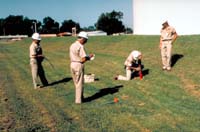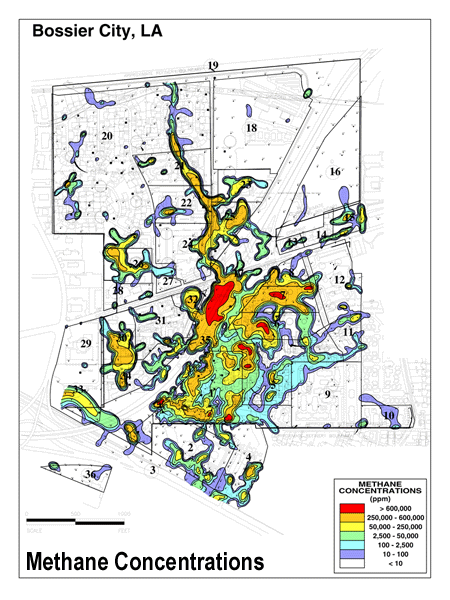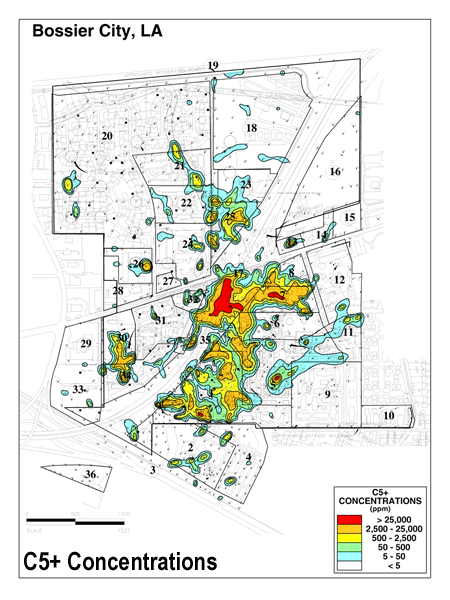
SOIL VAPOR INVESTIGATION - FORMER FUEL OIL REFINERY SITE
BACKGROUND
 Located
within the city limits of Bossier City, the former Arkansas Fuel Oil Refinery
site encompasses approximately 215 acres. The refinery operated from approximately
1923 through 1948 when operations were shut down and the process equipment
dismantled. However, the refinery's petroleum storage tanks continued to
be used until the mid-1960's. Subsequently, the site was cleared and the
property progressively developed. By 1988, single and multi-family homes
and commercial establishments covered a large portion of the site property.
In January 1990, after complaining of strong odors, a number of residents
were evacuated from an apartment complex located on site property. The residents
were evacuated as a precautionary measure and a subsequent preliminary investigation
revealed the presence of methane gas in the apartments. As a result of resident's
concerns, DEQ began working with OXY USA to thoroughly investigate the entire
site. The goal of the investigation was to determine the presence and extent
of contamination on the site and whether any materials discovered presented
a health hazard. To accomplish this goal, environmental contractors, working
under DEQ supervision, collected and analyzed thousands of samples. This
extensive sampling effort included testing soil gas, surface soil, deep
soil, ground water, surface water and indoor air.
Located
within the city limits of Bossier City, the former Arkansas Fuel Oil Refinery
site encompasses approximately 215 acres. The refinery operated from approximately
1923 through 1948 when operations were shut down and the process equipment
dismantled. However, the refinery's petroleum storage tanks continued to
be used until the mid-1960's. Subsequently, the site was cleared and the
property progressively developed. By 1988, single and multi-family homes
and commercial establishments covered a large portion of the site property.
In January 1990, after complaining of strong odors, a number of residents
were evacuated from an apartment complex located on site property. The residents
were evacuated as a precautionary measure and a subsequent preliminary investigation
revealed the presence of methane gas in the apartments. As a result of resident's
concerns, DEQ began working with OXY USA to thoroughly investigate the entire
site. The goal of the investigation was to determine the presence and extent
of contamination on the site and whether any materials discovered presented
a health hazard. To accomplish this goal, environmental contractors, working
under DEQ supervision, collected and analyzed thousands of samples. This
extensive sampling effort included testing soil gas, surface soil, deep
soil, ground water, surface water and indoor air.- Source: State of Louisiana Department of Environmental Quality, Vol. 4, No. 1, February 1995
The objectives of this investigation were to determine the presence and horizontal extent of any surface or near surface hydrocarbon constituents. In order to achieve this objective, a soil gas survey was conducted to define the horizontal extent of any hydrocarbon constituents present in the subsurface environment as a result of refining operations at the former Fuel Oil Refinery, possible pipeline releases and/or the seepage of deep petrogenic gases from abandoned well casings.
Deep reservoir gas samples were also collected from two producing oil and gas well located in the vicinity of the site, from producing wells from the Nacatoch and Pettet formations.
Analytical results of these reservoir gas samples were compared with analyses of the soil gas samples collected on the former refinery site in order to determine the similarities and/or differences in the compositions of the hydrocarbon compounds present.
Selected soil gas samples were plotted, showing that the ethane isotope compositions are very similar to those of the Pettet Formation gas sample. As expected, these samples contain more negative (higher numerical value) methane compositions as a result of the mixing of biogenically generated methane with methane derived from an oil and gas reservoir. This graph suggests that petrogenic gases from the Pettet Formation may be present in the Red River sand (at depths of 40-150 feet) throughout the study area.


Light hydrocarbon analyses (C1-C4) measure the lightest, most volatile constituents present in deep source gases as well as refined products. Methane, ethane, propane and butane are present in varying concentrations in oil and gas reservoirs and refined petroleum products. These light hydrocarbon compounds tend to dissipate rapidly with time and/or distance from the point(s) at which petroleum constituents are introduced into the subsurface environment. Light hydrocarbon analyses allow for the identification and differentiation of natural gas, biogenic methane, gasoline and other processed petroleum products. Methane is also generated biogenically in very large concentrations in the presence of NAPL contamination. Methane as large as 600,000 ppm (60%) was found to coincide with the location of C5+ range hydrocarbons derived directly from NAPL, as shown in the figure, the anaerobic methane very closely maps the heavier hydrocarbon contamination.
C5+ (gasoline range) hydrocarbon analyses yield a quantitative measure of the actual concentration, by volume, of gasoline type vapors present in near surface soils. Gasoline range hydrocarbons dissipate more slowly than lighter fraction (C1-C4) compounds. Due to the large number of individual hydrocarbon present in naturally occurring and processed petroleum products, the results of C5+ analyses were grouped according to the relative boiling points of the various compounds. The largest magnitude C5+ anomalies, located at the intersection of Interstate Hwy. 20 and Minden Hwy., were found to be associated with over 10 feet of free product NAPL, identified by four different laboratories as JP4 jet fuel.
CONCLUSIONS
Evaluation of the chemical and isotopic compositions of both the shallow
gases and their deeper potential sources clearly demonstrated that the
presence of, and relative compositional levels of the heavier petroleum
components (such as pentane, hexane, heptane, etc.) were incompatible
with the deep source gases, and can only be explained by the presence
of significant levels of fairly fresh petroleum products contained within
shallow sediments. The pentane plus alkane hydrocarbon levels analyzed
in the soil gas and liquid samples were too high to have been derived
from refinery related products which have been present in subsurface soils
for in excess of 40 years. The contributions of the deep gases appeared
to be minor.
The majority of the soil gas anomalies identified appeared to have a relatively
fresh petroleum signature, containing an abundance of normal alkane hydrocarbon
compounds. Several liquid product samples were encountered and extracted
from the near surface soils from areas where strong odors were noted by
the ETI soil gas sampling crew. Results of gas chromatography analyses
indicate that the product samples contained significant levels of normal
C5 to C12 alkanes, not typical of gasoline, kerosene or diesel. Products
such as jet fuels are known to contain an abundance of normal alkane hydrocarbon
compounds (within the C5 to C12 range) typical to those gases which have
been collected and measured within the Fuel Oil Refinery Site, in obvious
association with the high methane and other light hydrocarbon concentrations.
| Home | Exploration Geochemistry Services | Environmental Geochemistry Services |
©2002 Exploration Technologies, Inc.